
This week, we’ll begin to cover the early contributions of the Hanna-Barbera studio to the circus genre. H-B probably set the record of all producers of television cartoons for number of stories including a circus angle. Of course, this may possibly be attributable to the fact that H-B was a veritable footage mill, churning out more episodes and series than any two of its closest competitors combined. Yet, at least in its early years, the studio maintained a high level of script quality, as well as a respectable knack for appealing graphics and attractive character design. In their heyday, if you were a kid and you weren’t watching Hanna-Barbera, you weren’t watching television.
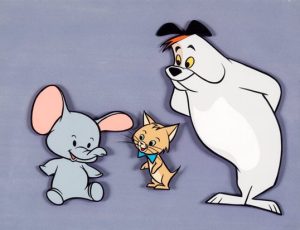 Almost from the very beginning of the studio’s output, the circus bug had bittten the studio’s writing staff. Ruff and Reddy’s second story arc was Pinky, the Pint-Sized Pachyderm (1/11/58 – 2/8/38). Our story opens in the backyard home of Ruff and Reddy, who have hit the hay for the day after spending an exciting afternoon at the circus. Reddy for one has left visible evidence of his personal passion from the day’s festivities – a large bag of circus peanuts just outside his doghouse, with several of the nuts scattered across the grass of the lawn. Quietly, so as not to disturb the sleeping populace, the circus trucks begin to roll out of town with the packed-up show. A tiger sleeps in one wagon with its tail knotted around one of the bars of the cage, providing a fur-covered “line” from which its small offspring slings a hammock. Mama Kangaroo’s small “Joey” spends the night reading in bed, with a night light rigged close to mama’s pouch. But one circus performer is not relaxing. A small gray trunk becomes visible at the barred window of one wagon, pulling out the steel bars by the roots. It is surprising that the owner of the trunk has so much strength – because the wagon’s resident is not an adult elephant, but only a small baby named Pinky, who is homesick for his Mama. Readers of this series of articles will recognize Pinky as a simplification in design from the MGM Tom and Jerry classic, “Jerry and Jumbo”. With minimal effort, Pinky scrambles out the window and is free, but looks for a place to hide out to keep the circus trainers from discovering him. Ruff and Reddy’s back yard is opportunistically close by, and Pinky enters the gate, hiding in some bushes. He spots the peanuts laying around the yard, and in a direct lift of a principal gag from “Jerry and Jumbo”, sucks up the peanuts long-distance with his trunk. (Differences in production budgets for this repeated gag are striking in comparison: the MGM original features an elaborately-choreographed precision march of the nuts into the hall closet, while the Ruff and Reddy version gets across the idea with the use of only a single cel, slid across the background.) Pinky’s suction pulls in more than the nuts, next getting hold of Ruff’s milk dish, and then Ruff himself. As Ruff stops cold seated atop Pinky’s truck, the hand of Reddy enters the shot, wielding a small branch which Reddy uses as a weapon, to whack at the strange gray appendage, which the boys believe is a rattlesnake. Poor Pinky emerges from hiding into full view, with his nose throbbing in some pain, and his speech affected to make his pronunciation quite nasal. Our puzzled heroes inquire what an elephant is doing out loose in the middle of the night, and Pinky explains that he escaped to try to get home to his Mama. Danger suddenly looms for Pinky, as two circus trainers pass each other on the other side of the yard fence, comparing notes on their search for the escaped pachyderm. To cover for the little guy, when one of the trainers opens the gate to make inquiry for the elephant, Ruff and Reddy seem to be nonchalantly watering petunias in the yard. Of course, no one but the audience notices that the spraying “hose” nozzle is small and gray – Pinky’s trunk, with the elephant hiding behind the standing Reddy. The suspicioys trainer asks what the idea is watering petunias at midnight, and Reddy responds “Why not? They’re night-blooming petunias.” The trainer walks away shaking his head, with the remark, “Sheesh! It takes all kinds.” Pinky shakes his new-found friends’ hands in gratitude, but Reddy modestly makes little of their quick-thinking. “That’s okay. Some folks save stamps – and we save elephants.” Ruff volunteers their services to help Pinky find his Mama, and Pinky talks our heroes into swearing a promise to help – then drops the bombshell that Mama’s address is 123 Pachyderm Place, Africa. (Shades of “8-Ball Bunny” – “Oooh, I’m DIE-ing!”)
Almost from the very beginning of the studio’s output, the circus bug had bittten the studio’s writing staff. Ruff and Reddy’s second story arc was Pinky, the Pint-Sized Pachyderm (1/11/58 – 2/8/38). Our story opens in the backyard home of Ruff and Reddy, who have hit the hay for the day after spending an exciting afternoon at the circus. Reddy for one has left visible evidence of his personal passion from the day’s festivities – a large bag of circus peanuts just outside his doghouse, with several of the nuts scattered across the grass of the lawn. Quietly, so as not to disturb the sleeping populace, the circus trucks begin to roll out of town with the packed-up show. A tiger sleeps in one wagon with its tail knotted around one of the bars of the cage, providing a fur-covered “line” from which its small offspring slings a hammock. Mama Kangaroo’s small “Joey” spends the night reading in bed, with a night light rigged close to mama’s pouch. But one circus performer is not relaxing. A small gray trunk becomes visible at the barred window of one wagon, pulling out the steel bars by the roots. It is surprising that the owner of the trunk has so much strength – because the wagon’s resident is not an adult elephant, but only a small baby named Pinky, who is homesick for his Mama. Readers of this series of articles will recognize Pinky as a simplification in design from the MGM Tom and Jerry classic, “Jerry and Jumbo”. With minimal effort, Pinky scrambles out the window and is free, but looks for a place to hide out to keep the circus trainers from discovering him. Ruff and Reddy’s back yard is opportunistically close by, and Pinky enters the gate, hiding in some bushes. He spots the peanuts laying around the yard, and in a direct lift of a principal gag from “Jerry and Jumbo”, sucks up the peanuts long-distance with his trunk. (Differences in production budgets for this repeated gag are striking in comparison: the MGM original features an elaborately-choreographed precision march of the nuts into the hall closet, while the Ruff and Reddy version gets across the idea with the use of only a single cel, slid across the background.) Pinky’s suction pulls in more than the nuts, next getting hold of Ruff’s milk dish, and then Ruff himself. As Ruff stops cold seated atop Pinky’s truck, the hand of Reddy enters the shot, wielding a small branch which Reddy uses as a weapon, to whack at the strange gray appendage, which the boys believe is a rattlesnake. Poor Pinky emerges from hiding into full view, with his nose throbbing in some pain, and his speech affected to make his pronunciation quite nasal. Our puzzled heroes inquire what an elephant is doing out loose in the middle of the night, and Pinky explains that he escaped to try to get home to his Mama. Danger suddenly looms for Pinky, as two circus trainers pass each other on the other side of the yard fence, comparing notes on their search for the escaped pachyderm. To cover for the little guy, when one of the trainers opens the gate to make inquiry for the elephant, Ruff and Reddy seem to be nonchalantly watering petunias in the yard. Of course, no one but the audience notices that the spraying “hose” nozzle is small and gray – Pinky’s trunk, with the elephant hiding behind the standing Reddy. The suspicioys trainer asks what the idea is watering petunias at midnight, and Reddy responds “Why not? They’re night-blooming petunias.” The trainer walks away shaking his head, with the remark, “Sheesh! It takes all kinds.” Pinky shakes his new-found friends’ hands in gratitude, but Reddy modestly makes little of their quick-thinking. “That’s okay. Some folks save stamps – and we save elephants.” Ruff volunteers their services to help Pinky find his Mama, and Pinky talks our heroes into swearing a promise to help – then drops the bombshell that Mama’s address is 123 Pachyderm Place, Africa. (Shades of “8-Ball Bunny” – “Oooh, I’m DIE-ing!”)
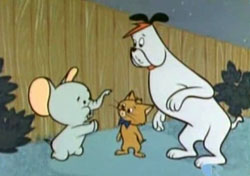 The remainder of the story takes many varied twists and turns, none of which have any connection to the circus theme. A brief synopsis finds our trio boarding as stowaways the only ship at the docks bound for Africa – the Voodoo Queen, a battered old merchant steamer run by a captain who still fancies himself an “irate pirate”, one Cross Bones Jones, with his wise-cracking parrot. Much ado ensues when our heroes are thrown in the brig for their stowaway status, climaxing in an escape and the blowing up of the ship. Ruff, Reddy and Pinky end up adrift in a raft, with a needle-nosed swordfish closing in. Pinky uses his trunk to jet-propel the raft to land. There, while scouting the unfamiliar jungle shore, Ruff is captured by a villainous big game hunter, Scary Harry Safari. (This character may be the most plagiaristic of all of Hanna-Barbera cartoon villains, bearing a striking resemblance in both appearance and voice to Dishonest John, from the then in puppet form adventures of “Time For Beany” by Bob Clampett, which resemblance can hardly be called a mere coincidence, despite both characters having derivation from standard stereotypes of melodrama stage villains.) Harry ties Ruff to a tree to use as bait to capture the king of beasts – but Ruff quickly bluffs his way out of peril by reminding the lion that a cat and a lion are cousins, forming an instant comradery with the lion. When Harry learns of Pinky’s presence, the elephant seems like another worthwhile trophy, and so does Pinky’s Mama, who is also lured into the chase in attempt to rescue her child. In the penultimate chapter, Harry seems to have succeeded in getting the drop on everybody – but makes the biggest mistake of his career, having allowed his rifle to run out of bullets (a fact which Harry first learns of through the informing words of the narrator, breaking the fourth wall). The lion plays upon this interchange with the narration too, gloating to Harry, “You heard what the man said – not loaded!” Pinky’s Mom and the lion team up to inflict a little vengeance upon Harry, including a game of tic-tac-toe played in claw scratches on the seat of Harry’s pants. Pinky is reunited with Mama, and Ruff and Reddy are bidded a bon voyage, as they stow away in the luggage compartment of a plane winging home.
The remainder of the story takes many varied twists and turns, none of which have any connection to the circus theme. A brief synopsis finds our trio boarding as stowaways the only ship at the docks bound for Africa – the Voodoo Queen, a battered old merchant steamer run by a captain who still fancies himself an “irate pirate”, one Cross Bones Jones, with his wise-cracking parrot. Much ado ensues when our heroes are thrown in the brig for their stowaway status, climaxing in an escape and the blowing up of the ship. Ruff, Reddy and Pinky end up adrift in a raft, with a needle-nosed swordfish closing in. Pinky uses his trunk to jet-propel the raft to land. There, while scouting the unfamiliar jungle shore, Ruff is captured by a villainous big game hunter, Scary Harry Safari. (This character may be the most plagiaristic of all of Hanna-Barbera cartoon villains, bearing a striking resemblance in both appearance and voice to Dishonest John, from the then in puppet form adventures of “Time For Beany” by Bob Clampett, which resemblance can hardly be called a mere coincidence, despite both characters having derivation from standard stereotypes of melodrama stage villains.) Harry ties Ruff to a tree to use as bait to capture the king of beasts – but Ruff quickly bluffs his way out of peril by reminding the lion that a cat and a lion are cousins, forming an instant comradery with the lion. When Harry learns of Pinky’s presence, the elephant seems like another worthwhile trophy, and so does Pinky’s Mama, who is also lured into the chase in attempt to rescue her child. In the penultimate chapter, Harry seems to have succeeded in getting the drop on everybody – but makes the biggest mistake of his career, having allowed his rifle to run out of bullets (a fact which Harry first learns of through the informing words of the narrator, breaking the fourth wall). The lion plays upon this interchange with the narration too, gloating to Harry, “You heard what the man said – not loaded!” Pinky’s Mom and the lion team up to inflict a little vengeance upon Harry, including a game of tic-tac-toe played in claw scratches on the seat of Harry’s pants. Pinky is reunited with Mama, and Ruff and Reddy are bidded a bon voyage, as they stow away in the luggage compartment of a plane winging home.
Scary Tale on a Canyon Trail (1/10/59 – 2/7/59) reunites Ruff and Reddy with Harry Safari, in a comeback tale that finds the three of them at Grand Canyon. One might say this is something of a double-sequel, as the third story arc of the series, “Westward Ho-Ho-Ho”, had resulted from an intended vacation to the Grand Canyon, which is derailed when Reddy hits the only highway signpost in 100 miles, rerouting the boys’ trailer to the ghost town of Gruesome Gulch and a sheep-rustling mystery. It took until the series’ third season, but our heroes finally make it to the Grand Canyon for their intended vacation. Harry, however, is at the Canyon on what might be called a working holiday. He has taken up a new line of business, operating a traveling carnival show (as we later see, actually more of a circus), with Harry as ringmaster. But he is still prone to his old ways of villainous shenanigans to make a fast buck, and equally as prone as ever to abuse of animals. Harry has heard tell of the unsolved legends of the canyon, about the recurrent rumors of the existence of midget horses somewhere hidden within the canyon’s depths. (Note that Hanna and Barbera “borrowed” this plot idea second-hand in a remembrance of their MGM days, the same motivation being the central plot point of Dick Lundy’s Barney Bear episode, “Half-Pint Palomino”.) Harry is determined that if anyone can find these midget mustangs (and turn a substantial profit from them in the same breath), it is Harry himself.
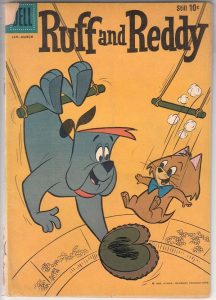 Reddy obtains a rental burro named Poco Loco for the mile-deep trip to the canton floor. The burro and Reddy do not seem to get along, and Reddy is thrown while still in the corral. Reddy vows to walk instead, leaving his mount to Ruff. Harry also rents a burro, and is right behind our boys. Partway down the trail, Poco Loco balks, refusing to budge for Ruff. Ever sensitive to animal feelings, Harry suggests giving the stubborn burro the old “needle” – by way of a cactus needle to stick into the burro’s behind. Poco Loco is not going to stick around for such mistreatment, and takes off like a shot without Ruff as his rider. Reddy, however, is in the way of Poco’s escape trail, and the burro collides with him, picking Reddy up as an unwitting passenger, as Poco speeds along the trail down hairpin curves, nearly throwing Reddy off the canyon cliffs. When Ruff finally reaches the canyon floor in pursuit of Reddy, he finds millions of burro tracks everywhere – but one singular set of tracks leading up a lonely canyon. On a hope and a hunch, Ruff follows the solitary trail – to find Reddy, draped over the side of a canyon wall, above a small entrance to a cave tunnel. The weary Reddy moans, “He ducked under that rock – but I forgot to duck.” Ruff explores the mystery cave, with Reddy reluctantly following. To their wonderment, they discover a hidden canyon at the other end of the tunnel, which is the home of two midget horses – a baby colt (which our heroes name Pee Wee) and his mother – both of which are small enough to fit in the palm of Reddy’s hand. Poco Loco even develops a conversational friendship with both mother and son. Our heroes retrieve Poco Loco, and vow to keep their discovery of the midget horses a secret. However, Harry Safari overhears their conversation as they leave the tunnel entrance, and the secret is out.
Reddy obtains a rental burro named Poco Loco for the mile-deep trip to the canton floor. The burro and Reddy do not seem to get along, and Reddy is thrown while still in the corral. Reddy vows to walk instead, leaving his mount to Ruff. Harry also rents a burro, and is right behind our boys. Partway down the trail, Poco Loco balks, refusing to budge for Ruff. Ever sensitive to animal feelings, Harry suggests giving the stubborn burro the old “needle” – by way of a cactus needle to stick into the burro’s behind. Poco Loco is not going to stick around for such mistreatment, and takes off like a shot without Ruff as his rider. Reddy, however, is in the way of Poco’s escape trail, and the burro collides with him, picking Reddy up as an unwitting passenger, as Poco speeds along the trail down hairpin curves, nearly throwing Reddy off the canyon cliffs. When Ruff finally reaches the canyon floor in pursuit of Reddy, he finds millions of burro tracks everywhere – but one singular set of tracks leading up a lonely canyon. On a hope and a hunch, Ruff follows the solitary trail – to find Reddy, draped over the side of a canyon wall, above a small entrance to a cave tunnel. The weary Reddy moans, “He ducked under that rock – but I forgot to duck.” Ruff explores the mystery cave, with Reddy reluctantly following. To their wonderment, they discover a hidden canyon at the other end of the tunnel, which is the home of two midget horses – a baby colt (which our heroes name Pee Wee) and his mother – both of which are small enough to fit in the palm of Reddy’s hand. Poco Loco even develops a conversational friendship with both mother and son. Our heroes retrieve Poco Loco, and vow to keep their discovery of the midget horses a secret. However, Harry Safari overhears their conversation as they leave the tunnel entrance, and the secret is out.
As the plot progresses, Harry tracks the trail into the cave tunnel, and encounters Pee Wee. He attempts to get a lasso on the steed, but the small horse leads Harry on a merry chase, delivering a powerful kick into the villain’s chin, then dragging him through a cactus parch and into the canton wall at the interior entrance to the cave. Harry follows the tracks of the tiny horse straight to Ruff and Reddy at the outer end of the tunnel (to whom Pee Wee has run for help). Reddy hides Pee Wee under his hat, but a sneeze from the small stallion gives him away. Poco Loco removes the threat of Harry’s pistol, by giving Harry a swift kick in the rear, that Reddy thinks will launch Harry as the first villain to land on the moon. But Harry isn’t stopped that easy, and knows that Pee Wee’s only way back home is through the cave tunnel, where he lies in wait to capture Pee Wee in a sack. (A technical note: at this point in the story, there begins a great number of continuity errors, in which images seem to be repeatedly flip-flopped, switching from left-to-right action to right-to-left action and vice versa, such that it becomes difficult to tell if characters are coming or going. One such flip-flop even shows shots repeated from the previous episode in a recap, but the action is reversed in direction, so we don’t know which end of the tunnel Harry is supposed to be at.) Harry escapes in a chase down-river in a stolen motorboat, and then on a motor scooter, running down our heroes in the process. Reddy comments, “I’m gonna start the “I hate Harry” Fan Club.”
Pee Wee is brought to the carnival grounds, where Harry assumes a ringmaster’s outfit and training duties. Cracking a whip violently at the small horse, the strands of the whip almost as wide as the horse himself, Harry forces Pee Wee to learn various circus routines, including jumping from a high platform into a tiny bucket of water, balancing atop a rolling drum, and acting as mount for Harry to ride, balanced atop a miniature saddle strapped to Pee Wee’s back. Pee Wee gets a small amount of revenge by stopping short in his gallop, throwing Harry off his back and forward from the momentum, face-first into the same bucket of water into which Pee Wee dived – but gets no supper for his giving Harry the “horse-laugh”. Finally, Pee Wee is made to enter the mouth of a small cannon, wearing a crash helmet and parachute. He is blasted into the air, then floats back to earth as his chute opens. Harry presumes audience turnout is assured with the attraction of the first horse cannon-ball, and locks Pee Wee in a small metal box, to await the opening of the carnival that evening.
Ruff, Reddy, and Poco Loco have been searching in vain from town to town, for some sign of the whereabouts of Harry’s show. Their clue finally materializes when Poco Loco attempts to eat a stray piece of paper that has blown in his direction, which turns out to be a handbill announcing Pee Wee’s debut in the next town. Upon arrival at the carnival grounds, our heroes snoop around, and quickly discover whinnying noises emitting from the locked box in Harry’s tent. But a whip crack across their backsides sticking out under the tent flap sends our heroes scurrying, as Harry threatens them with worse if they ever come back. Determined, the trio of would-be rescuers returns, and Reddy spots a costume tent, loaded with clown paraphernalia. In a twinkling, Ruff and Reddy emerge as clowns, mingling with the circus buffoons. The final chapter of the story is currently missing from the internet, so I go from distant memory of its viewing. Actually, the wrap-up seemed to me too simple and sudden in my childhood watchings of the series. Ruff and Reddy labor with a crowbar at the lock of Pee Wee’s box, while Harry delivers an elaborate announcement and build-up to the crowd for the debut of Pee Wee. Instead of the horse, Poco Loco creeps up behind Harry in the arena, and delivers another powerful kick to launch Harry into orbit again. Without further retribution or detail as to what became of Harry, and why there are no further acts of dirty work to catch up with them, Ruff and Reddy return Pee Wee to the secret canyon entrance. As Pee Wee whinnies a good-bye to our heroes and Poco Loco, the head of his mother is seen above him In the entrance to the cave tunnel, grabbing Pee wee by the mane, and dragging him back into the cave. We are left with the narrator’s word that if Pee Wee’s Mama has her way, there’ll be no more accidental sightings of the midget horses ever again – which still seems small assurance as to why Harry couldn’t track them down once more if he chooses to return to the canyon. But 13 chapters have been used up, so we have to end the story somewhere.
H-B’s gallery of animal character stars was broad and world-renown in the years that immediately followed. We’ll cover somewhat randomly some of these early series to fill out this chapter of our trail.
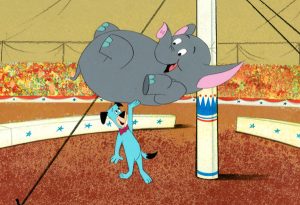 Huckleberry Hound would begin the studio’s rise to prime-time fame. In keeping with the spirit of our trail, the credits and bumpers of the show were structured during the first season in a circus theme, with Huck as ringmaster. At least two versions of the opening and closing credits were filmed. Resyndicated versions (filmed in color) show Huck cavorting on a circus grounds, tooting seal horns, hitting a high striker, musically conducting an elephant who plays clarinet notes with his trunk, then engaging in acrobatics with the elephant on a teeter-totter, from which Huck is launched into the air, falls out of frame, the rises riding in a balloon with his name painted on it. The closing sequence has Huck’s head seen protruding through a paper hoop, them depicts a mad ride in a clown car, where principal cast members of the show are picked up in a ride around the arena, the smallest one (Yakky Doodle) hitting his head on the tent exit as the car departs, with Huck having to run back in and catch him before making his exit. These, however, are significant reworkings of the original animation for the opening and closing sequences, which was entirely sponsor-driven. For one thing, Huckleberry himself never appeared in the original opening credits, except in still pictures on circus wagins, banners, etc. Instead, all of Huck’s action was performed by Cornelius Rooster, spokes-character for Kellogg’s Corn Flakes. Cornelius even opened the titles with an added shot, as a box of Corn Flakes zooms straight at the camera, filling the screen, and Cornelius gives a mighty crow from the face of the cereal box. There are also two sets of balloons seen at the end of the opening sequence in the Cornelius version, the gas bag of the large balloon advertising Kellogg’s, with the rooster holding signs about “The best to you each morning”. Then, the balloon punctures, and Cornelius drops out of sight, only to rise again holding a large batch of toy balloons, each with a letter thereon reading together “Huckleberry Hound”. These balloons pop again for an abrupt drop and fade out, which would lead into various bumpers created to introduce the characters of the various segments of the show, each beginning with Cornelius dropping down to the foot of a wagon door with a star on it. Cornelius would knock on the door, and Huck would make his appearance from behind it, swinging the door wide so that Cornelius would disappear from view.
Huckleberry Hound would begin the studio’s rise to prime-time fame. In keeping with the spirit of our trail, the credits and bumpers of the show were structured during the first season in a circus theme, with Huck as ringmaster. At least two versions of the opening and closing credits were filmed. Resyndicated versions (filmed in color) show Huck cavorting on a circus grounds, tooting seal horns, hitting a high striker, musically conducting an elephant who plays clarinet notes with his trunk, then engaging in acrobatics with the elephant on a teeter-totter, from which Huck is launched into the air, falls out of frame, the rises riding in a balloon with his name painted on it. The closing sequence has Huck’s head seen protruding through a paper hoop, them depicts a mad ride in a clown car, where principal cast members of the show are picked up in a ride around the arena, the smallest one (Yakky Doodle) hitting his head on the tent exit as the car departs, with Huck having to run back in and catch him before making his exit. These, however, are significant reworkings of the original animation for the opening and closing sequences, which was entirely sponsor-driven. For one thing, Huckleberry himself never appeared in the original opening credits, except in still pictures on circus wagins, banners, etc. Instead, all of Huck’s action was performed by Cornelius Rooster, spokes-character for Kellogg’s Corn Flakes. Cornelius even opened the titles with an added shot, as a box of Corn Flakes zooms straight at the camera, filling the screen, and Cornelius gives a mighty crow from the face of the cereal box. There are also two sets of balloons seen at the end of the opening sequence in the Cornelius version, the gas bag of the large balloon advertising Kellogg’s, with the rooster holding signs about “The best to you each morning”. Then, the balloon punctures, and Cornelius drops out of sight, only to rise again holding a large batch of toy balloons, each with a letter thereon reading together “Huckleberry Hound”. These balloons pop again for an abrupt drop and fade out, which would lead into various bumpers created to introduce the characters of the various segments of the show, each beginning with Cornelius dropping down to the foot of a wagon door with a star on it. Cornelius would knock on the door, and Huck would make his appearance from behind it, swinging the door wide so that Cornelius would disappear from view.
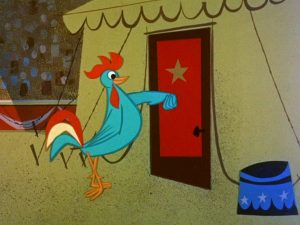 The closing credits animation was also entirely reworked. In the original, Huck is not within the paper hoop. Instead, Huck and Yogi Bear (who was then a mere supporting character in a segment of Huck’s show, until given his own series as a spin-off) enter the frame, carrying signs again about “The best to you each morning”. The clown car enters through the hoop, intercepting Huck, who is still standing in front of the hoop, and gets picked up on the car’s hood. The closing theme is at least twice as long in this version, with a full verse of sung lyric, as the car picks up not members of the cast of the show, but the spokes-characters of’ Kellogg’s’ entire line of cereals. Cornelius Rooster is in the driver’s seat, with a large box of his Corn flakes in the rear seat. Passengers include Snap, Crackle, and Pop (the Rice Krispies elves), Smaxey the Seal (Sugar Smacks), Tony the Tiger and Tony Jr. (Sugar Frosted Flakes), and Sugar Pops Pete (Sugar Pops). Tony Jr. takes the whack in the head at the tent exit. Two versions of an added final shot exist, one showing the shapes of circus tents and lettering in the sky of the show’s name and “A Hanna-Barbera Production”, the other fading to the Columbia Studios “proud lady” and a credit to Screen Gems Production.
The closing credits animation was also entirely reworked. In the original, Huck is not within the paper hoop. Instead, Huck and Yogi Bear (who was then a mere supporting character in a segment of Huck’s show, until given his own series as a spin-off) enter the frame, carrying signs again about “The best to you each morning”. The clown car enters through the hoop, intercepting Huck, who is still standing in front of the hoop, and gets picked up on the car’s hood. The closing theme is at least twice as long in this version, with a full verse of sung lyric, as the car picks up not members of the cast of the show, but the spokes-characters of’ Kellogg’s’ entire line of cereals. Cornelius Rooster is in the driver’s seat, with a large box of his Corn flakes in the rear seat. Passengers include Snap, Crackle, and Pop (the Rice Krispies elves), Smaxey the Seal (Sugar Smacks), Tony the Tiger and Tony Jr. (Sugar Frosted Flakes), and Sugar Pops Pete (Sugar Pops). Tony Jr. takes the whack in the head at the tent exit. Two versions of an added final shot exist, one showing the shapes of circus tents and lettering in the sky of the show’s name and “A Hanna-Barbera Production”, the other fading to the Columbia Studios “proud lady” and a credit to Screen Gems Production.
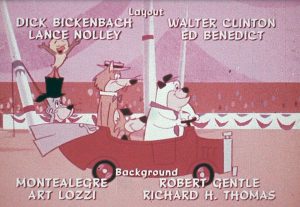 One further note of curiosity. Pixie and Dixie and Mr. Jinks remained a part of the Huckleberry cast both before and after the spinning-off of Yogi Bear. In place of Yogi, Huck acquired Hokey Wolf and Ding-a-Ling, while Yogi introduced as new members of his own cast Snagglepuss and Yakky Doodle and Chopper. So why is Chopper the driver of the clown car in the redrawn closing credits, and Yakky a passenger? How come Pixie, Dixie, and Jinks never rode in the car? By the time the series made resyndication without sponsor on local stations, things were getting pretty confused anyway, with all Yogi episodes from the pre- and post-Huck periods being lumped together, and the remaining cartoons of both series dropped in rather randomly, sometimes in an hour package in some markets. So the cross-over in cast in the clown car might have reflected some general opinion as to whether Yakky’s popularity had eclipsed that of Pixie and Dixie by such time. Yakky’s small stature would have also made him a good substitute in place of Tony Jr. – although one could have done as well by choosing either Pixie or Dixie to take the head whack and be caught by Huck. Maybe the animators just couldn’t decide which of the mice should take the fall, so avoided the question by axing them altogether from the issue.
One further note of curiosity. Pixie and Dixie and Mr. Jinks remained a part of the Huckleberry cast both before and after the spinning-off of Yogi Bear. In place of Yogi, Huck acquired Hokey Wolf and Ding-a-Ling, while Yogi introduced as new members of his own cast Snagglepuss and Yakky Doodle and Chopper. So why is Chopper the driver of the clown car in the redrawn closing credits, and Yakky a passenger? How come Pixie, Dixie, and Jinks never rode in the car? By the time the series made resyndication without sponsor on local stations, things were getting pretty confused anyway, with all Yogi episodes from the pre- and post-Huck periods being lumped together, and the remaining cartoons of both series dropped in rather randomly, sometimes in an hour package in some markets. So the cross-over in cast in the clown car might have reflected some general opinion as to whether Yakky’s popularity had eclipsed that of Pixie and Dixie by such time. Yakky’s small stature would have also made him a good substitute in place of Tony Jr. – although one could have done as well by choosing either Pixie or Dixie to take the head whack and be caught by Huck. Maybe the animators just couldn’t decide which of the mice should take the fall, so avoided the question by axing them altogether from the issue.
A selection of bumpers and bridges from the show, including a few of the Cornelius Rooster-opened circus theme bumpers, is included for your enjoyment.
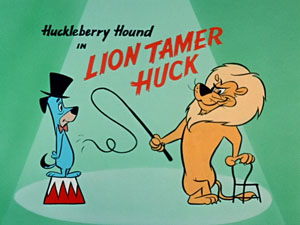 Lion Tamer Huck (3/10/59) follows the classic model of the Goofy “How To” shorts of the 1940’s, substituting Huck in the role of the Goof on a topic the original series never touched. At the mercy of Don Messick as the dignified narrator, the basic equipment for lion taming is laid out on screen – a cage, whip, pistol, chair, and a foolhardy…er, fearless individual. Huck fits the bill, appearing in a blink on the screen. Plus one other ingredient – a ferocious lion. Such a specimen also appears, adding “That’s me folks.” But the narrator adds the option that some beginners prefer to start with a more puny-type lion. A tired example of same, less than half the size of the jungle king already on screen, appears. A relieved Huck enthusiastically comments, “Oh, that I like”, but the larger lion doesn’t. “Oh no, ya don’t Shorty. Scram, Sam”, he growls. In a voice sounding like the soon-to-be Sadcat from Terrytoons, the puny lion responds, “Thank you. I don’t feel at all well. And besides, I’ve got a headache”, then departs.
Lion Tamer Huck (3/10/59) follows the classic model of the Goofy “How To” shorts of the 1940’s, substituting Huck in the role of the Goof on a topic the original series never touched. At the mercy of Don Messick as the dignified narrator, the basic equipment for lion taming is laid out on screen – a cage, whip, pistol, chair, and a foolhardy…er, fearless individual. Huck fits the bill, appearing in a blink on the screen. Plus one other ingredient – a ferocious lion. Such a specimen also appears, adding “That’s me folks.” But the narrator adds the option that some beginners prefer to start with a more puny-type lion. A tired example of same, less than half the size of the jungle king already on screen, appears. A relieved Huck enthusiastically comments, “Oh, that I like”, but the larger lion doesn’t. “Oh no, ya don’t Shorty. Scram, Sam”, he growls. In a voice sounding like the soon-to-be Sadcat from Terrytoons, the puny lion responds, “Thank you. I don’t feel at all well. And besides, I’ve got a headache”, then departs.
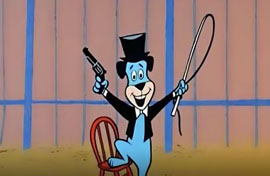 A battle of wits begins, as the narrator relates that the big cats can sense the slightest signs of fear. Huck nonchalantly hums “Oh, My Darling Clementine”, and strikes a careless pose – but below his facade, his knees are knocking. The lion begins his own war of nerves, designed to induce a nervous breakdown. First, his huge claws spring out from his paw one by one. The lion breaks out a grinding wheel, and sharpens his claws to razor points. The narrator advises Huck to laugh a little – if you can. Huck flashes his teeth in an oversize but sickly grin. The lion now uses a metal file to floss his teeth, again fine-tuning their natural sharpness – then eats the metal file. The narrator advises that the lion may in reality be as scared as you are – but one snarling growl from the beast causes the narrator to add, “But we sincerely doubt it.” The narrator next advises that Huck should approach with the whip, and apply a light flick on the lion’s nose to assert mastery. Huck’s whip snaps, but the narrator cautions, “Ah ah aah! We said lightly!” The lion roars with pain, setting up a complaining spell of “Oh, my nose, my nose” as the beast grips his throbbing schnozzola, followed by a rage of anger, as the big cat calls Huck, “That little whippersnapper!” The lion stampedes Huck out of the cage, and as the door slams in the lion’s face, the lion rants, “Dog-gone amateur!”
A battle of wits begins, as the narrator relates that the big cats can sense the slightest signs of fear. Huck nonchalantly hums “Oh, My Darling Clementine”, and strikes a careless pose – but below his facade, his knees are knocking. The lion begins his own war of nerves, designed to induce a nervous breakdown. First, his huge claws spring out from his paw one by one. The lion breaks out a grinding wheel, and sharpens his claws to razor points. The narrator advises Huck to laugh a little – if you can. Huck flashes his teeth in an oversize but sickly grin. The lion now uses a metal file to floss his teeth, again fine-tuning their natural sharpness – then eats the metal file. The narrator advises that the lion may in reality be as scared as you are – but one snarling growl from the beast causes the narrator to add, “But we sincerely doubt it.” The narrator next advises that Huck should approach with the whip, and apply a light flick on the lion’s nose to assert mastery. Huck’s whip snaps, but the narrator cautions, “Ah ah aah! We said lightly!” The lion roars with pain, setting up a complaining spell of “Oh, my nose, my nose” as the beast grips his throbbing schnozzola, followed by a rage of anger, as the big cat calls Huck, “That little whippersnapper!” The lion stampedes Huck out of the cage, and as the door slams in the lion’s face, the lion rants, “Dog-gone amateur!”
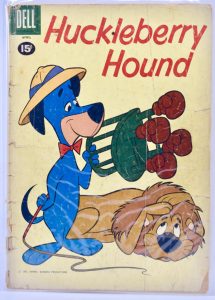 Huck next approaches with both whip and chair, but, against the narrator’s recommendation, disturbs the lion while he is eating. Huck admits he never knew just what a lion tamer needs a chair for – then finds out. It is needed so the lion can hit the lion tamer with it. Huck again races for the cage exit, but this time forgets to close the door. Both of our combatants exit, then Huck races back inside, slamming the door to keep the lion out. The lion casually but sternly demands, “Hey, boy, you mind if I get back in my own cage?” Huck apologizes, “Sorry sir, my mistake.” The two politely restore order to the situation, Huck opening the door, and the lion passing into the cage without incident, but adding, “They keep sending in boys to do a man’s job.”
Huck next approaches with both whip and chair, but, against the narrator’s recommendation, disturbs the lion while he is eating. Huck admits he never knew just what a lion tamer needs a chair for – then finds out. It is needed so the lion can hit the lion tamer with it. Huck again races for the cage exit, but this time forgets to close the door. Both of our combatants exit, then Huck races back inside, slamming the door to keep the lion out. The lion casually but sternly demands, “Hey, boy, you mind if I get back in my own cage?” Huck apologizes, “Sorry sir, my mistake.” The two politely restore order to the situation, Huck opening the door, and the lion passing into the cage without incident, but adding, “They keep sending in boys to do a man’s job.”
The lion remains obstinate, refusing to be tamed, and sticking his tongue out at Huck. “You asked for it”, threatens Huck, producing his pistol, firing several shots into the air. The lion darts behind a platform, begging for Huck not to shoot, as he is gun shy. Pleasantly surprised, Huck remarks that now this lion knows who’s boss – until the paw of the lion enters the frame, and nimbly lifts the gun from Huck’s hand. Suddenly, as if in an old Western, the lion has the drop on Huck. “Cute trick, huh Shorty?” he gloats, adding in best Quick Draw McGraw tradition, “Now I’m givin’ you ‘til sundown to get outta town. Start a runnin’, I’m a-gunnin’!” Huck makes another hasty exit from the cage, amidst a hail of gunfire. Using the old classic gag dating back to at least the Tex Avery days, Huck refreshes himself at a water cooler, remarking that he knew all along the gun was only firing blanks – as water spouts from bullet holes everywhere in his lower torso.
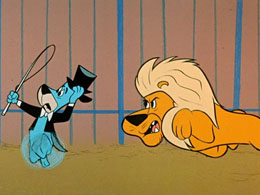 Next step is to teach the lion to jump through a flaming hoop. The narrator notes that this may require a little demonstration. Huck shows how it’s done, repeatedly hopping back and forth through the ring of flame – until a small blaze ignites his tail. Huck is quickly charred to blackness, and his hat reduced to ashes in an audible poof. Final trick is to train the lion to walk a tightrope. Huck cracks the whip at the lion from below, while the beast performs the precarious feat. Talking like Joe Besser (of Three Stooges infamy), the lion complains that Huck’s whipping makes him “so nervous!” Then, the lion feels one of his “dizzy spells” coming on. In an ending that comes a bit too suddenly, the lion falls, squarely upon Huck. All that the lion can find underneath him is Huck’s crushed hat, to which he remarks, “It’s hust as well. This kid wasn’t gonna make it anyhow.” The film could have used one more sequence for a better wrapup, but it was great fun while it lasted.
Next step is to teach the lion to jump through a flaming hoop. The narrator notes that this may require a little demonstration. Huck shows how it’s done, repeatedly hopping back and forth through the ring of flame – until a small blaze ignites his tail. Huck is quickly charred to blackness, and his hat reduced to ashes in an audible poof. Final trick is to train the lion to walk a tightrope. Huck cracks the whip at the lion from below, while the beast performs the precarious feat. Talking like Joe Besser (of Three Stooges infamy), the lion complains that Huck’s whipping makes him “so nervous!” Then, the lion feels one of his “dizzy spells” coming on. In an ending that comes a bit too suddenly, the lion falls, squarely upon Huck. All that the lion can find underneath him is Huck’s crushed hat, to which he remarks, “It’s hust as well. This kid wasn’t gonna make it anyhow.” The film could have used one more sequence for a better wrapup, but it was great fun while it lasted.
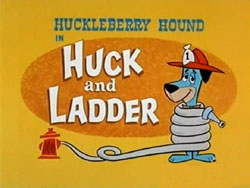 Huck and Ladder (12/1/61) – Colonel Cornball, owner of a circus, has a problem. A gorilla has gotten loose inside the big top. The customers have fled – and stay so, as the gorilla refuses to come out or be captured. A circus roustabout (whom the Colonel always calls “Rube”, even though his real name is Cicero) suggests maybe he should call the fire department, as they’re good at helping animals like getting cats out of trees, etc. A call is placed to Huck’s station. When Huck hears that an animal is in distress, he inquires, “What kind?” He gets an evasive answer, with Huck left to express that he only asked to satisfy his curiosity. The Colonel gets Huck to admit the department doesn’t discriminate in giving aid – an animal is an animal – then quietly lets slip at the end of the call that it’s a gorilla, after Huck has already blurted out that he’ll be right down. Dawn breaks only after Huck has hung up the phone, and Huck realizes he’s sworn to uphold the reputation of the Department by fulfilling his promise. He arrives with his hook and ladder truck, and the Colonel explains the situation of why the customers won’t come. “I detect a slight hint of commercialism, Colonel”, notes Huck. “That’s right, son”, responds the Colonel, “It isn’t laughs we’re workin’ for, it’s loot!” Huck checks to see if the ape is still in the tent, receiving a quick answer in the form of a sock in the jaw from a hairy hand. Now formally introduced, Huck walks in as “your old pal, Huckleberry”, and receives another sock through the roof of the big top. Landing on the ground outside with a thud, Huck speculates as to what would have happened if he wasn’t “your old pal Huckleberry.”
Huck and Ladder (12/1/61) – Colonel Cornball, owner of a circus, has a problem. A gorilla has gotten loose inside the big top. The customers have fled – and stay so, as the gorilla refuses to come out or be captured. A circus roustabout (whom the Colonel always calls “Rube”, even though his real name is Cicero) suggests maybe he should call the fire department, as they’re good at helping animals like getting cats out of trees, etc. A call is placed to Huck’s station. When Huck hears that an animal is in distress, he inquires, “What kind?” He gets an evasive answer, with Huck left to express that he only asked to satisfy his curiosity. The Colonel gets Huck to admit the department doesn’t discriminate in giving aid – an animal is an animal – then quietly lets slip at the end of the call that it’s a gorilla, after Huck has already blurted out that he’ll be right down. Dawn breaks only after Huck has hung up the phone, and Huck realizes he’s sworn to uphold the reputation of the Department by fulfilling his promise. He arrives with his hook and ladder truck, and the Colonel explains the situation of why the customers won’t come. “I detect a slight hint of commercialism, Colonel”, notes Huck. “That’s right, son”, responds the Colonel, “It isn’t laughs we’re workin’ for, it’s loot!” Huck checks to see if the ape is still in the tent, receiving a quick answer in the form of a sock in the jaw from a hairy hand. Now formally introduced, Huck walks in as “your old pal, Huckleberry”, and receives another sock through the roof of the big top. Landing on the ground outside with a thud, Huck speculates as to what would have happened if he wasn’t “your old pal Huckleberry.”
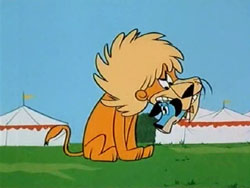 Huck breaks out the fire hose, intent on cooling the gorilla off. (This cartoon is a real cheater on animation, as we haven’t even seen the gorilla yet except for a momentary show of his fist – and still don’t as Huck enters the tent.) A scuffle is heard but not seen inside, only visually represented by several jerks on the hose, and Huck is tossed out, knotted up in the hose, and bobbing high up in the air at hose end as the water gushes like a fountain from the nozzle. Huck asks the Colonel to turn off the water – which the Colonel does all the way, letting Huck fall to the ground. “I shoulda said, gradual, like”, moans Huck. “We’re making progress”, Huck next observes, stating that the gorilla’s thinking process is emerging, and operational pattern is taking shape. “In other words – he’s smarter than we are.” But Huck vows to think liike a gorilla, and approaches walking on his arms in the manner of an ape. The writing hits a convenient inconsistency, as the gorilla, formerly noted as refusing to leave the tent, is suddenly seen outside. (Doesn’t this already solve part of the Colonel’s problem without Huck’s intervention?) Huck engages in a game of “Monkey see, monkey do”, luring the ape back to his cage. Huck goes in the door, but the gorilla stops outside in confusion. Huck demonstrates again, re-entering the cage door. The gorilla ambles up to the door, but merely locks it upon Huck. As Huck begs for the ape to let him out, Rube runs into the scene to tell the Colonel that a lion has also gotten loose. The beast charges into the area, and the ape thinks better about his and Huck’s respective positions, opening the cage door to admit himself in – and toss Huck out. Huck pounds on the cage door again, but from the opposite side to be let in. The ape won’t share living quarters. Before Huck knows it, he is being shaken around while clenched in the lion’s jaws. Suddenly, a fire alarm is heard from the station. Huck notes his overriding duty to drop whatever he is doing and answer the call of the fire bell under all circumstances – and pries himself loose of the lion, making an escape to his engine. Huck is thankful for that department rule, because in this case, he was really “saved by the bell.”
Huck breaks out the fire hose, intent on cooling the gorilla off. (This cartoon is a real cheater on animation, as we haven’t even seen the gorilla yet except for a momentary show of his fist – and still don’t as Huck enters the tent.) A scuffle is heard but not seen inside, only visually represented by several jerks on the hose, and Huck is tossed out, knotted up in the hose, and bobbing high up in the air at hose end as the water gushes like a fountain from the nozzle. Huck asks the Colonel to turn off the water – which the Colonel does all the way, letting Huck fall to the ground. “I shoulda said, gradual, like”, moans Huck. “We’re making progress”, Huck next observes, stating that the gorilla’s thinking process is emerging, and operational pattern is taking shape. “In other words – he’s smarter than we are.” But Huck vows to think liike a gorilla, and approaches walking on his arms in the manner of an ape. The writing hits a convenient inconsistency, as the gorilla, formerly noted as refusing to leave the tent, is suddenly seen outside. (Doesn’t this already solve part of the Colonel’s problem without Huck’s intervention?) Huck engages in a game of “Monkey see, monkey do”, luring the ape back to his cage. Huck goes in the door, but the gorilla stops outside in confusion. Huck demonstrates again, re-entering the cage door. The gorilla ambles up to the door, but merely locks it upon Huck. As Huck begs for the ape to let him out, Rube runs into the scene to tell the Colonel that a lion has also gotten loose. The beast charges into the area, and the ape thinks better about his and Huck’s respective positions, opening the cage door to admit himself in – and toss Huck out. Huck pounds on the cage door again, but from the opposite side to be let in. The ape won’t share living quarters. Before Huck knows it, he is being shaken around while clenched in the lion’s jaws. Suddenly, a fire alarm is heard from the station. Huck notes his overriding duty to drop whatever he is doing and answer the call of the fire bell under all circumstances – and pries himself loose of the lion, making an escape to his engine. Huck is thankful for that department rule, because in this case, he was really “saved by the bell.”
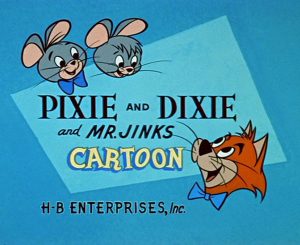 Another element of the Huck show was Pixie and Dixie and Mr. Jinks. It was the immediate successor to Tom and Jerry, placing mice Pixie and Dixie in the Jerry and Tuffy roles and Mr. Jinks as Tom, merely substituting snappy dialogue for much of the frenetic pantomime chasing of the original. As in the theatrical series, many plots would be motivated by the walk-on appearance of various outsiders of assorted species – some from the circus. Three such instances appear in the series.
Another element of the Huck show was Pixie and Dixie and Mr. Jinks. It was the immediate successor to Tom and Jerry, placing mice Pixie and Dixie in the Jerry and Tuffy roles and Mr. Jinks as Tom, merely substituting snappy dialogue for much of the frenetic pantomime chasing of the original. As in the theatrical series, many plots would be motivated by the walk-on appearance of various outsiders of assorted species – some from the circus. Three such instances appear in the series.
Boxing Buddy (3/26/59) harkens to the old Hippety Hopper cartoons of Warner Brothers, with a few nods to some Tom and Jerry moments from the past. While the mice walk home along a suburban sidewalk, a circus truck passes them, bearing Kapow, world’s champion boxing kangaroo. A crate inside the rear bed of the truck suddenly hops off and into the street. The crate is hit by a following car, and smashes into a nearby wall. The side of the crate falls open, and out hops Kapow, a baby kangaroo in turtle-neck sweater and wearing boxing gloves, somehow unhurt, but fighting mad. He thumbs his nose, and throws practice jabs right and left, ready to face any opponent. Pixie and Dixie attempt to talk to the Champ, but find (despite Dixie adopting an Australian accent to address him) that Kapow is not lingual, but only jabbers in an unintelligible babble (the sound is produced by Don Messick, in a sort of gobble that he would later adapt as the alien voices of Gloop and Gleep in the Herculoids, and had already used in a slightly varied tone as the sounds of the Muni-Mula men in Ruff and Reddy’s first story arc). Not knowing what to do with him, Pixie and Dixie invite the kangaroo to follow them home. There, they meet Mr. Jinks in the yard, who overhears Dixie commenting to Kapow that they will treat him like a brother. “Brother? Oh, brother!”, remarks Jinks. The cat stops Kapow cold in his tracks, by stepping on the kangaroo’s tail. Jinks reminds Pixie and Dixie that it is his job to see that the property is not overrun by mice, and demands that Kapow, and the “meeces”, leave the premises. The mice begin to inform Jinks that Kapow isn’t a mouse, but Jinks responds that it’s a cat’s business to know a mouse when he sees one. He adds, “Why don’t you try that old worn-out gag, and tell me it’s a kangaroo?” Predictable antics occur, as Jinks begins to get clobbered by upper cuts from Kapow, again and again and again.
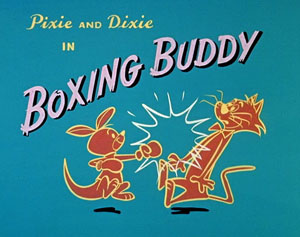 Jinks goes through an intensive program of physical training (exactly as Sylvester did in “Hop, Look, and Listen”, and as Tom did in “Jerry’s Cousin”), only to get flattened again. Jinks decides the problem is that he’s been fighting fair, and appears with an old barrel around him as a wooden suit of armor. Jinks sneaks in lefts and rights from over and under the rim of the barrel and through a knothole in the side, until Kapow kicks the barrel soundly with both feet. The barrel slams into a tree, then falls apart, revealing staggering Jinks, appearing to use the barrel rings as hula hoops. Jinks packs up a bindle stick with his meager belongings, and prepares to leave the premises, realizing there’s no place for a cat who cannot beat up on a mouse. But Kapow’s trainer arrives on the scene, retrieving the kangaroo and reminding him that he has a television appearance scheduled for tonight. A mouse on television? This Jinks has got to see. That night, he and the mice watch the broadcast in their living room. Kapow is introduced by an announcer as a boxing kangaroo, and Jinks’s old confidence is restored. Jinks begins to boast that if that phoney baloney showed up here again, Jinks would show him a thing or two. His boasting is met by a left jab in the face, delivered by Kapow through the TV screen (a gag staged nearly identically to Cousin Pecos’s whisker pull of Tom from the TV set in Tom and Jerry’s “Pecos Pest”). Jinks changes demeanor, declaring “Why don’t I just keep quiet, y’know?”, as he faints dead away, Kapow smiling at the camera for the closing.
Jinks goes through an intensive program of physical training (exactly as Sylvester did in “Hop, Look, and Listen”, and as Tom did in “Jerry’s Cousin”), only to get flattened again. Jinks decides the problem is that he’s been fighting fair, and appears with an old barrel around him as a wooden suit of armor. Jinks sneaks in lefts and rights from over and under the rim of the barrel and through a knothole in the side, until Kapow kicks the barrel soundly with both feet. The barrel slams into a tree, then falls apart, revealing staggering Jinks, appearing to use the barrel rings as hula hoops. Jinks packs up a bindle stick with his meager belongings, and prepares to leave the premises, realizing there’s no place for a cat who cannot beat up on a mouse. But Kapow’s trainer arrives on the scene, retrieving the kangaroo and reminding him that he has a television appearance scheduled for tonight. A mouse on television? This Jinks has got to see. That night, he and the mice watch the broadcast in their living room. Kapow is introduced by an announcer as a boxing kangaroo, and Jinks’s old confidence is restored. Jinks begins to boast that if that phoney baloney showed up here again, Jinks would show him a thing or two. His boasting is met by a left jab in the face, delivered by Kapow through the TV screen (a gag staged nearly identically to Cousin Pecos’s whisker pull of Tom from the TV set in Tom and Jerry’s “Pecos Pest”). Jinks changes demeanor, declaring “Why don’t I just keep quiet, y’know?”, as he faints dead away, Kapow smiling at the camera for the closing.
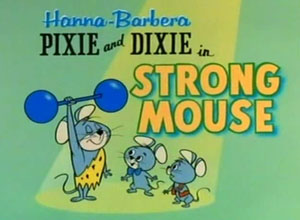 Strong Mouse (9/1/61) could be said to owe a debt to “Jerry’s Cousin” for inspiration – although by this time in the series, there had already been several other stories that had copy-catted this formula, including most prominently the early episode “Judo Jack”, which had completely lifted the ending from the theatrical cartoon. This derivative plays up a different sequence of the MGM original – where a gang of tough-guy cats are called in to take care of the intruding super-powered mouse. Here, the tough cats make their entrance early, as two of them, sent to observe Jinks, watch an incident where Jinks is sweet-talked by flattery from the mice into overlooking a theft of Jinks’ milk from the refrigerator, the incident closing with apologies and words of friendship. “Seen enough?”, asks one of the tough cats to the other, and the two hoods move in. Jinks is told by the cats that Gus wants to see him – now. Jinks cowers, and is forced to accompany the “boys” out to the alley, where Gus, kingpin of the tough alley cats of the neighborhood, cautions Jinks that he’s been hearing stories about Jinks being pals with mice – something that could give cats a bad name, making people think they were going soft. Jinks is cautioned to tow the line, but given one more chance to redeem himself, while Gus’s “boys” are assigned to be watching.
Strong Mouse (9/1/61) could be said to owe a debt to “Jerry’s Cousin” for inspiration – although by this time in the series, there had already been several other stories that had copy-catted this formula, including most prominently the early episode “Judo Jack”, which had completely lifted the ending from the theatrical cartoon. This derivative plays up a different sequence of the MGM original – where a gang of tough-guy cats are called in to take care of the intruding super-powered mouse. Here, the tough cats make their entrance early, as two of them, sent to observe Jinks, watch an incident where Jinks is sweet-talked by flattery from the mice into overlooking a theft of Jinks’ milk from the refrigerator, the incident closing with apologies and words of friendship. “Seen enough?”, asks one of the tough cats to the other, and the two hoods move in. Jinks is told by the cats that Gus wants to see him – now. Jinks cowers, and is forced to accompany the “boys” out to the alley, where Gus, kingpin of the tough alley cats of the neighborhood, cautions Jinks that he’s been hearing stories about Jinks being pals with mice – something that could give cats a bad name, making people think they were going soft. Jinks is cautioned to tow the line, but given one more chance to redeem himself, while Gus’s “boys” are assigned to be watching.
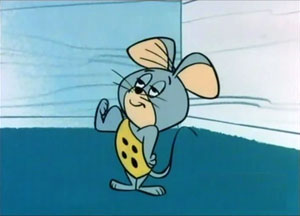 Meanwhile, the mice receive a visit from Hercules, a cousin who is a strong mouse in the circus. Hercules demonstrates a part of his act, lifting a grand piano with one hand. Hercules asks if Jinks needs any “going over” to keep him in line, but Pixie and Dixie state that Junks is their pal and no problem. Pixie nevertheless decides to pull a trick on Jinks, switching clothes with Hercules, so that the strong mouse can lift the piano before Jinks’ eyes, leaving him thinking that Pixie is that strong. The mice never get to pull off the trick as planned, as Jinks enters the house with menace in his eye, induced by the “boys” outside to get busy in mistreating the mice or else. As Jinks points an intimidating finger at “Pixie”, Hercules grabs it, and judo flips the cat, then flings him across the room and out the door, landing with a thud at the feet of the tough cats. Much like the bulldog in the early Hippety Hopper cartoons, the “boys” announce that seeing such a thing happen makes them feel ashamed to be a cat, and Jinks is tossed back inside. The predictable happens, as another encounter with Hercules gets Jinks tossed out again, this time knocked cold as he collides with a fence. The two tough cats, just as with the bulldog in Hippety Hopper films, decide to take matters into their own hands, entering the house to clobber the mice. They too are tossed out into the fence, and join Jinks in unconscious state. Who should observe this but Gus, who repeats the action by himself going in, and is also abruptly tossed out on his ear. The film ends with Jinks’ return, informing the mice that Gus has changed his mind, and said it was okay for cats to be friends with meeces. Pixie and Hercules reveal how they fooled everyone, and Hercules takes his leave, giving Jinks a final flip instead of a handshake, as a reminder to be nice to mice. “I get the message – oh boy!” says Jinks for the curtain line.
Meanwhile, the mice receive a visit from Hercules, a cousin who is a strong mouse in the circus. Hercules demonstrates a part of his act, lifting a grand piano with one hand. Hercules asks if Jinks needs any “going over” to keep him in line, but Pixie and Dixie state that Junks is their pal and no problem. Pixie nevertheless decides to pull a trick on Jinks, switching clothes with Hercules, so that the strong mouse can lift the piano before Jinks’ eyes, leaving him thinking that Pixie is that strong. The mice never get to pull off the trick as planned, as Jinks enters the house with menace in his eye, induced by the “boys” outside to get busy in mistreating the mice or else. As Jinks points an intimidating finger at “Pixie”, Hercules grabs it, and judo flips the cat, then flings him across the room and out the door, landing with a thud at the feet of the tough cats. Much like the bulldog in the early Hippety Hopper cartoons, the “boys” announce that seeing such a thing happen makes them feel ashamed to be a cat, and Jinks is tossed back inside. The predictable happens, as another encounter with Hercules gets Jinks tossed out again, this time knocked cold as he collides with a fence. The two tough cats, just as with the bulldog in Hippety Hopper films, decide to take matters into their own hands, entering the house to clobber the mice. They too are tossed out into the fence, and join Jinks in unconscious state. Who should observe this but Gus, who repeats the action by himself going in, and is also abruptly tossed out on his ear. The film ends with Jinks’ return, informing the mice that Gus has changed his mind, and said it was okay for cats to be friends with meeces. Pixie and Hercules reveal how they fooled everyone, and Hercules takes his leave, giving Jinks a final flip instead of a handshake, as a reminder to be nice to mice. “I get the message – oh boy!” says Jinks for the curtain line.
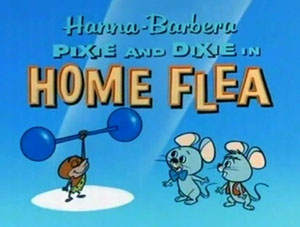 Home Flea (10/13/61) was the final episode in the “meeces” series – and quite talky as opposed to action-filled. It is poor man’s rip-off of Warner’s “To Itch His Own”, featuring a former flea-circus strong man (Mighty Mite) in search of a comfortable home to relax in his post-employment years on a nice lazy dog. Pixie and Dixie suggest they have a nice lazy cat available, but Mighty isn’t so sure, believing cats are too active, with staying up all night, climbing fences, etc. so that a flea never gets any sleep. Nevertheless, he mounts Jinks for a trial run. Jinks awakens to a feeling that he’s not alone, but with no evidence of anyone around, assumes it’s purely delusional. He falls into his usual morning bad mood, moistening a broom in the sink to give Pixie and Dixie a clobbering with the old “wet broom” treatment. Seeing Jinks picking on his friends, Mighty gives Jinks a judo flip from his tail. Mighty decides his hunch was right that a cat is too active for a home, but before leaving, decides to cure Junks of the wet broom habit, by conditioning the cat reflexively to avoid the broom, giving him unseen judo flips every time Jinks attempts to touch the broomstick. Jinks tries to excuse the phenomenon on dizzy spells and inner ear disturbances, but still can’t manage an approach on the stick without being pummeled to the ground. In the end, Jinks simply gives up, but announces to the “meeces” that he will come up with a new game to make their lives miserable. “I like-always do”, he closes.
Home Flea (10/13/61) was the final episode in the “meeces” series – and quite talky as opposed to action-filled. It is poor man’s rip-off of Warner’s “To Itch His Own”, featuring a former flea-circus strong man (Mighty Mite) in search of a comfortable home to relax in his post-employment years on a nice lazy dog. Pixie and Dixie suggest they have a nice lazy cat available, but Mighty isn’t so sure, believing cats are too active, with staying up all night, climbing fences, etc. so that a flea never gets any sleep. Nevertheless, he mounts Jinks for a trial run. Jinks awakens to a feeling that he’s not alone, but with no evidence of anyone around, assumes it’s purely delusional. He falls into his usual morning bad mood, moistening a broom in the sink to give Pixie and Dixie a clobbering with the old “wet broom” treatment. Seeing Jinks picking on his friends, Mighty gives Jinks a judo flip from his tail. Mighty decides his hunch was right that a cat is too active for a home, but before leaving, decides to cure Junks of the wet broom habit, by conditioning the cat reflexively to avoid the broom, giving him unseen judo flips every time Jinks attempts to touch the broomstick. Jinks tries to excuse the phenomenon on dizzy spells and inner ear disturbances, but still can’t manage an approach on the stick without being pummeled to the ground. In the end, Jinks simply gives up, but announces to the “meeces” that he will come up with a new game to make their lives miserable. “I like-always do”, he closes.
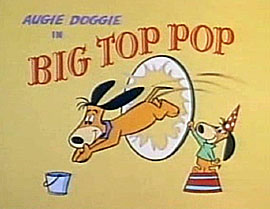 To fit the confines of this week’s article, we’ll skip to a series from HB’s next big success of the airwaves, The Quick Draw McGraw Show. Augie Doggie and Doggie Daddy held the third berth in this half-hour comedy package, which show was structured to lampoon three television genres that were currently flooding the airwaves of live-action TV – the Western, the detective mystery, and the family sitcom. Augie provided the latter format, being the apple of his Doggie Daddy’s eye, but a constant source of trouble for “Dear ol’ Dad” from his energetic playfulness, scientific I.Q. far in excess of his father, and general ability to place Pop onto high-risk situations. In Big Top Pop (11/14/59), Augie is going through a childhood phase, announcing (with loving admiration for all his Dad has done for him) that he is running away forever to join the circus. Daddy (as he himself notes, by fortuitous coincidence) just happens to be reading a book on child psychology, which advises that in such circumstances, the parent should go along with the gag, play along with the child, until he develops a new interest. Dad suggests that he’s been wanting to run away to join a circus, too, and suggests that he and Augie become a circus family and work up an act like all those other famous circus family troupes. Writer Michael Maltese shows glimmers of remembrances from his prior Warner work on “Bear Feat”, approaching several sequences in close approximation to his prior gags. For one, Daddy’s opening act on the high wire. Daddy holds a log of medium weight as a balance bar, as he steps out on a clothesline. The line stretches under the combined weight of Daddy and the log, dropping Daddy halfway to the ground. Realizing the log is too heavy, Daddy tosses it away – causing the rope to repeatedly slingshot him upwards, for a headfirst smack into an overhanging tree limb, then fall upon the wire again for repeated flings again and again into the tree branch. (You’ll recall that Junyer Bear provided the excess weight for a similar gag in the Warner original.)
To fit the confines of this week’s article, we’ll skip to a series from HB’s next big success of the airwaves, The Quick Draw McGraw Show. Augie Doggie and Doggie Daddy held the third berth in this half-hour comedy package, which show was structured to lampoon three television genres that were currently flooding the airwaves of live-action TV – the Western, the detective mystery, and the family sitcom. Augie provided the latter format, being the apple of his Doggie Daddy’s eye, but a constant source of trouble for “Dear ol’ Dad” from his energetic playfulness, scientific I.Q. far in excess of his father, and general ability to place Pop onto high-risk situations. In Big Top Pop (11/14/59), Augie is going through a childhood phase, announcing (with loving admiration for all his Dad has done for him) that he is running away forever to join the circus. Daddy (as he himself notes, by fortuitous coincidence) just happens to be reading a book on child psychology, which advises that in such circumstances, the parent should go along with the gag, play along with the child, until he develops a new interest. Dad suggests that he’s been wanting to run away to join a circus, too, and suggests that he and Augie become a circus family and work up an act like all those other famous circus family troupes. Writer Michael Maltese shows glimmers of remembrances from his prior Warner work on “Bear Feat”, approaching several sequences in close approximation to his prior gags. For one, Daddy’s opening act on the high wire. Daddy holds a log of medium weight as a balance bar, as he steps out on a clothesline. The line stretches under the combined weight of Daddy and the log, dropping Daddy halfway to the ground. Realizing the log is too heavy, Daddy tosses it away – causing the rope to repeatedly slingshot him upwards, for a headfirst smack into an overhanging tree limb, then fall upon the wire again for repeated flings again and again into the tree branch. (You’ll recall that Junyer Bear provided the excess weight for a similar gag in the Warner original.)
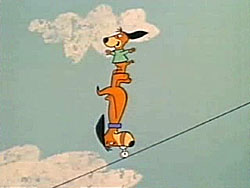 A teeter-totter acrobatic jump, intended to land Dad in an easy chair after a triple somersault, ends in Daddy climaxing his somersaulting by diving down the chimney of the house into the fireplace (another feat Papa Bear performed in the original). A new act involves a two-man slide for life down a slanted wire, with Daddy balanced upside-down on a roller-skate wheel attached to his nose (lifting a trick from Fox and Crow’s “The Egg Yegg”). Daddy performs the trick successfully, but once reaching the ground, continues to roll in a downward slant, carving a ditch until his body is submerged into the ground down to his ankles. Augie, riding atop Daddy’s feet, wonders how Dad plans to take a bow after this performance. Deciding to play it more safe, Daddy rigs up a clown act for himself and Augie, in which Augie is to hide in a king-size hollowed-out firecracker, then emerge when Daddy lights the fuse to squirt Daddy with a water pistol. Somehow, Augie’s pistol turns out to be a real one, blasting Daddy with gunpowder in the face. Daddy turns to the audience, observing, “I think we all knew that was gonna happen.” A two-man trapeze act results in a head-in collision of the participants rather than an exchange of trapeze bars (again, closely parallel to the head-on jumping through a hoop gag from both sides in “Bear Feat”). Finally, Daddy performs a jump of 100 feet onto a trampoline, bouncing into the mouth of a cannon, from which he is supposed to be fired into a distant net. Something goes amiss, and Daddy never blasts out of the cannon barrel, instead taking the full force of the explosion while remaining in the cannon. Daddy suggests they postpone further rehearsal until tomorrow, as he is pooped. Augie advises him that no more rehearsal is needed, as he has tired of the circus, and has moved on to a new interest. He now wants to raise crocodiles in the bathtub. Daddy closes with a remark to the audience that, after going through trying to raise a son, he’d actually welcome working with crocodiles.
A teeter-totter acrobatic jump, intended to land Dad in an easy chair after a triple somersault, ends in Daddy climaxing his somersaulting by diving down the chimney of the house into the fireplace (another feat Papa Bear performed in the original). A new act involves a two-man slide for life down a slanted wire, with Daddy balanced upside-down on a roller-skate wheel attached to his nose (lifting a trick from Fox and Crow’s “The Egg Yegg”). Daddy performs the trick successfully, but once reaching the ground, continues to roll in a downward slant, carving a ditch until his body is submerged into the ground down to his ankles. Augie, riding atop Daddy’s feet, wonders how Dad plans to take a bow after this performance. Deciding to play it more safe, Daddy rigs up a clown act for himself and Augie, in which Augie is to hide in a king-size hollowed-out firecracker, then emerge when Daddy lights the fuse to squirt Daddy with a water pistol. Somehow, Augie’s pistol turns out to be a real one, blasting Daddy with gunpowder in the face. Daddy turns to the audience, observing, “I think we all knew that was gonna happen.” A two-man trapeze act results in a head-in collision of the participants rather than an exchange of trapeze bars (again, closely parallel to the head-on jumping through a hoop gag from both sides in “Bear Feat”). Finally, Daddy performs a jump of 100 feet onto a trampoline, bouncing into the mouth of a cannon, from which he is supposed to be fired into a distant net. Something goes amiss, and Daddy never blasts out of the cannon barrel, instead taking the full force of the explosion while remaining in the cannon. Daddy suggests they postpone further rehearsal until tomorrow, as he is pooped. Augie advises him that no more rehearsal is needed, as he has tired of the circus, and has moved on to a new interest. He now wants to raise crocodiles in the bathtub. Daddy closes with a remark to the audience that, after going through trying to raise a son, he’d actually welcome working with crocodiles.
You ain‘t seen nothing yet. The cavalcade of H-B circuses continues next week.


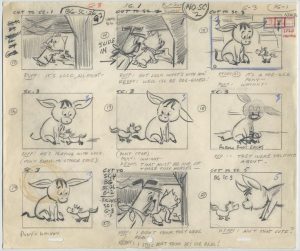
 Charles Gardner is an animation enthusiast who toils by day as a member of LA Law – but by nights and weekends indulges in classic jazz and ragtime as a performer; and studies classic Hollywood cartoons… maybe a little too much.
Charles Gardner is an animation enthusiast who toils by day as a member of LA Law – but by nights and weekends indulges in classic jazz and ragtime as a performer; and studies classic Hollywood cartoons… maybe a little too much.


































































































































































These take me back to some of my earliest memories.
Harry Safari really is Dishonest John, right down to the same staccato “Nya-ah-ah!” laugh. The Hanna-Barbera penchant for reusing material, both their own and others’, was already manifest in the studio’s early days. Even the bit with a game of tic-tac-toe clawed into the seat of somebody’s pants had been done before in the 1934 Ub Iwerks cartoon “Puss in Boots” — though if that was reused deliberately, then either Bill or Joe or Charlie Shows must have had a phenomenal memory.
There’s a third Huckleberry Hound cartoon that probably deserves to be mentioned here. “Huck Hound’s Tale” (16/10/60) is a sequel to the first-season episode “Hokum Smokum”, in which our hero captured the Indian Chief Crazy Coyote. In the sequel, Huck has parlayed his fame into a gig in a Wild West show, performing as “Buffalo Huck”. The show takes place inside a Big Top tent and resembles a circus in many details, and the man who runs the show is referred to as the “circus manager”. When the news breaks that Chief Crazy Coyote has escaped from the reservation, the circus manager tells Huck that he has to capture the crazy Indian all over again, or else he’ll lose his job.
It’s true that a lot of Hanna-Barbera cartoons take place in a circus. You’re probably going to have to devote an entire post to Yogi Bear alone.
Two Ruff and Reddy arcs, two Huck Hound shorts, a half-hour of Pixie and Dixie, and topped off with an Auggie Doggie cartoon. And this is just part one. Oy.
On the bright side, the ending to Boxing Buddy is something I wish we got in a Hippety Hopper outing, where Sylvester figures out it’s not a “baby mouse” after all. But that’s just me.
Would you rather he talked about Filmation instead? There are even some episodes from the “Masters of the Universe” shows about the circus, one of which is consider by fans one of the worst episodes.
Also, the two cats did find out that Hippity was not a giant “mousthe” at the end of “Too Hop to Handle” (1956).
It’s a little sad that in those ’70s Hanna-Barbera reunion shows (“Yogi’s Ark”) Ruff and Reddy never appeared. I think if I’d been John Kricfalusi I’d have revived them in the ’80s. It’s rather like the way Max Fleischer dropped Koko and Bimbo in 1933 once he had Popeye, or all the toons who don’t appear in “Roger Rabbit” (most surprisingly Tom and Jerry, the top cartoon stars of the time the movie is set in).
But it’s no surprise that circus themes would be prevalent in those early days of the TV cartoon, since children are commonly perceived as loving circuses. Maybe, but I didn’t: I was taken to Ringling Brothers once, and found it boring. All I remember is the elephants standing around peeing, and that a balloon on a stick cost a dollar, which was a lot in those days. (You could get a mouse-eared helium balloon at Disneyland for half that.) But of course that’s the appeal of animation, illustrating fantasies and impressions that are more fun than dull reality.
Ruff and Reddy actually did appear at the beginning of the pilot of the show “Yogi’s Ark Lark” (1972) on their signature scooter.
For the record, Ruff and Reddy also made an appearance or two in the recent offbeat character mash-up series “Jellystone”, among junior students at the city school – cast as robotic (as well as of differing genders!) I can only assume that they weren’t the real Ruff and Reddy, but perhaps some of the clone duplicates they left behind on the planet Muni-mula!
Sometimes, I wish they had someone like Sholly Fisch in charge of the classic H-B characters instead.
Tilted, high-pitched videos being uploaded to Dailymotion by a user with lots of sockpuppet accounts (useranme and number), and being used in posts on this site
That’s nasty…
It is, but if the alternative is not being able to see these cartoons at all, I’ll put up with it.